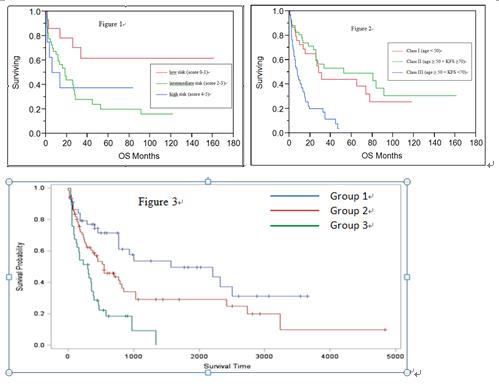
Contributions
Abstract: PB1719
Type: Publication Only
Background
Primary central nervous system lymphoma (PCNSL) is a rare type of non-Hodgkin’s lymphoma. Two independent prognostic scoring systems have been developed at the Memorial Sloan-Kettering Cancer Center (MSKCC) and the International Extranodal Lymphoma Study Group (IELSG). The former considers age and Karnofski’s performance status (PS) as prognostic parameters(JCO. 2006;24:5711). The latter includes age, Eastern Cooperative Oncology Group (ECOG) PS, the presence of deep lesions, serum lactate dehydrogenase (LDH) and total protein levels in the cerebrospinal fluid (CSF)(JCO 2003;21:266). Neither of the two systems has been verified in the Asian population, leading to concerns regarding applicability in this region.
Aims
This study was conducted to test the prognostic power of the 2 systems in PCNSL patients in Taiwan. In addition, we analyzed the parameters of the IELSG system to figure out the most powerful prognostic factors and then established a new scoring system.
Methods
The medical records of patients with tissue-proven PCNSL were retrieved from 15 academic hospitals in Taiwan through January 2002 to December 2011. They were stratified into different groups according to the MSKCC or the IELSG system and the overall survivals (OS) were evaluated. All parameters in the IELSG system were checked by multi-variable analysis to establish a new scoring system.
Results
When the IELSG scoring system was applied, the 2-year OS in low, intermediate and high-risk groups were 78.3%, 43.9% and 37.5% respectively with a crossover in the latter 2 groups(Figure 1). When the patients were stratified by the MSKCC scoring system, the 2-year OS of class I, II and III were 65%, 68% and 20%(Figure 2), respectively. We conducted single-variable analysis of the 5 parameters included in the IELSG scoring system and only age and ECOG PS were statistically significant. In the multi-variable analysis, these 2 factors were almost equally weighted. Based on these findings, we re-stratified the patients into 3 groups. Group 1 comprised patients with both age < 60 and ECOG PS < 2 and Group 3 with both age ≧ 60 and ECOG PS ≧ 2. The patients not fulfilling criteria of either Group1 or Group 3 were categorized as Group 2. According to this new scoring system, the median OS of Groups 1, 2 and 3 were 1,573, 548 and 304 days(Figure 3), respectively, and their OS curves could be nicely distinguished.

Conclusion
Neither the IELSG nor MSKCC scoring system is ideal to distinguish the 2-year OS of the PCNSL patients in Taiwan. The new scoring system comprising age ≧ 60 years and ECOG PS ≧ 2 seemed to provide a better prognostic power for Taiwanese patients.
Session topic: 20. Aggressive Non-Hodgkin lymphoma - Clinical
Keyword(s): Prognostic factor, Diffuse large B cell lymphoma, CNS lymphoma
Abstract: PB1719
Type: Publication Only
Background
Primary central nervous system lymphoma (PCNSL) is a rare type of non-Hodgkin’s lymphoma. Two independent prognostic scoring systems have been developed at the Memorial Sloan-Kettering Cancer Center (MSKCC) and the International Extranodal Lymphoma Study Group (IELSG). The former considers age and Karnofski’s performance status (PS) as prognostic parameters(JCO. 2006;24:5711). The latter includes age, Eastern Cooperative Oncology Group (ECOG) PS, the presence of deep lesions, serum lactate dehydrogenase (LDH) and total protein levels in the cerebrospinal fluid (CSF)(JCO 2003;21:266). Neither of the two systems has been verified in the Asian population, leading to concerns regarding applicability in this region.
Aims
This study was conducted to test the prognostic power of the 2 systems in PCNSL patients in Taiwan. In addition, we analyzed the parameters of the IELSG system to figure out the most powerful prognostic factors and then established a new scoring system.
Methods
The medical records of patients with tissue-proven PCNSL were retrieved from 15 academic hospitals in Taiwan through January 2002 to December 2011. They were stratified into different groups according to the MSKCC or the IELSG system and the overall survivals (OS) were evaluated. All parameters in the IELSG system were checked by multi-variable analysis to establish a new scoring system.
Results
When the IELSG scoring system was applied, the 2-year OS in low, intermediate and high-risk groups were 78.3%, 43.9% and 37.5% respectively with a crossover in the latter 2 groups(Figure 1). When the patients were stratified by the MSKCC scoring system, the 2-year OS of class I, II and III were 65%, 68% and 20%(Figure 2), respectively. We conducted single-variable analysis of the 5 parameters included in the IELSG scoring system and only age and ECOG PS were statistically significant. In the multi-variable analysis, these 2 factors were almost equally weighted. Based on these findings, we re-stratified the patients into 3 groups. Group 1 comprised patients with both age < 60 and ECOG PS < 2 and Group 3 with both age ≧ 60 and ECOG PS ≧ 2. The patients not fulfilling criteria of either Group1 or Group 3 were categorized as Group 2. According to this new scoring system, the median OS of Groups 1, 2 and 3 were 1,573, 548 and 304 days(Figure 3), respectively, and their OS curves could be nicely distinguished.

Conclusion
Neither the IELSG nor MSKCC scoring system is ideal to distinguish the 2-year OS of the PCNSL patients in Taiwan. The new scoring system comprising age ≧ 60 years and ECOG PS ≧ 2 seemed to provide a better prognostic power for Taiwanese patients.
Session topic: 20. Aggressive Non-Hodgkin lymphoma - Clinical
Keyword(s): Prognostic factor, Diffuse large B cell lymphoma, CNS lymphoma


